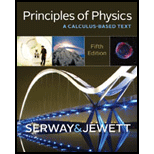
Concept explainers
(a)
The angle of the second order ray in diffraction grating.
(a)
Answer to Problem 60P
The angle of the second order ray in the diffraction grating that has
Explanation of Solution
Given info: The number of grooves per
Formula to calculate angle of
Here,
First calculate the grid spacing, formula to calculate grid spacing is,
Substitute
Substitute
Conclusion:
Therefore, The angle of the second order ray in the diffraction grating that has
(b)
The change in the angle of the second order ray in the diffraction grating if the apparatus is in water.
(b)
Answer to Problem 60P
If the apparatus is submerged in the water the angle of the second order ray in the diffraction grating that has
Explanation of Solution
Given info: The number of grooves per
From equation (1) formula to calculate angle of
Here,
The whole apparatus is now submerged into water therefore the wavelength of the incident light will be reduced to factor of the refractive index of water.
The new incident wavelength is
Here,
Substitute
From equation (6), substitute
Conclusion:
Therefore, if the apparatus is submerged in the water the angle of the second order ray in the diffraction grating that has
(c)
To show: The two diffracted rays from part (a) and part (b) are related through the law of refraction.
(c)
Answer to Problem 60P
The relation between the diffracted rays for the part (a) and part b is
Explanation of Solution
for the part (a) from equation (1),
For second order ray substitute
From equation (4) for the second part when the apparatus is submerged in water,
Form equation (5) Substitute
For second order, ray substitute
Compare equation (8) and (10).
Substitute
Here,
From equation (11), it is evident that it can be expressed in terms of law of refraction.
Conclusion:
Therefore, the two diffracted rays of part (a) and part (b) is related through law of refraction.
Want to see more full solutions like this?
Chapter 27 Solutions
Principles of Physics: A Calculus-Based Text
- A man slides two boxes up a slope. The two boxes A and B have a mass of 75 kg and 50 kg, respectively. (a) Draw the free body diagram (FBD) of the two crates. (b) Determine the tension in the cable that the man must exert to cause imminent movement from rest of the two boxes. Static friction coefficient USA = 0.25 HSB = 0.35 Kinetic friction coefficient HkA = 0.20 HkB = 0.25 M₁ = 75 kg MB = 50 kg P 35° Figure 3 B 200arrow_forwardA golf ball is struck with a velocity of 20 m/s at point A as shown below (Figure 4). (a) Determine the distance "d" and the time of flight from A to B; (b) Determine the magnitude and the direction of the speed at which the ball strikes the ground at B. 10° V₁ = 20m/s 35º Figure 4 d Barrow_forwardThe rectangular loop of wire shown in the figure (Figure 1) has a mass of 0.18 g per centimeter of length and is pivoted about side ab on a frictionless axis. The current in the wire is 8.5 A in the direction shown. Find the magnitude of the magnetic field parallel to the y-axis that will cause the loop to swing up until its plane makes an angle of 30.0 ∘ with the yz-plane. Find the direction of the magnetic field parallel to the y-axis that will cause the loop to swing up until its plane makes an angle of 30.0 ∘ with the yz-plane.arrow_forward
- A particle with a charge of − 5.20 nC is moving in a uniform magnetic field of (B→=−( 1.22 T )k^. The magnetic force on the particle is measured to be (F→=−( 3.50×10−7 N )i^+( 7.60×10−7 N )j^. Calculate the y and z component of the velocity of the particle.arrow_forwardneed answer asap please thank youarrow_forward3. a. Determine the potential difference between points A and B. b. Why does point A have a higher potential energy? Q = +1.0 C 3.2 cm 4.8 cm Aarrow_forward
 Principles of Physics: A Calculus-Based TextPhysicsISBN:9781133104261Author:Raymond A. Serway, John W. JewettPublisher:Cengage Learning
Principles of Physics: A Calculus-Based TextPhysicsISBN:9781133104261Author:Raymond A. Serway, John W. JewettPublisher:Cengage Learning Modern PhysicsPhysicsISBN:9781111794378Author:Raymond A. Serway, Clement J. Moses, Curt A. MoyerPublisher:Cengage Learning
Modern PhysicsPhysicsISBN:9781111794378Author:Raymond A. Serway, Clement J. Moses, Curt A. MoyerPublisher:Cengage Learning University Physics Volume 3PhysicsISBN:9781938168185Author:William Moebs, Jeff SannyPublisher:OpenStax
University Physics Volume 3PhysicsISBN:9781938168185Author:William Moebs, Jeff SannyPublisher:OpenStax Physics for Scientists and Engineers, Technology ...PhysicsISBN:9781305116399Author:Raymond A. Serway, John W. JewettPublisher:Cengage Learning
Physics for Scientists and Engineers, Technology ...PhysicsISBN:9781305116399Author:Raymond A. Serway, John W. JewettPublisher:Cengage Learning Physics for Scientists and Engineers with Modern ...PhysicsISBN:9781337553292Author:Raymond A. Serway, John W. JewettPublisher:Cengage Learning
Physics for Scientists and Engineers with Modern ...PhysicsISBN:9781337553292Author:Raymond A. Serway, John W. JewettPublisher:Cengage Learning Physics for Scientists and EngineersPhysicsISBN:9781337553278Author:Raymond A. Serway, John W. JewettPublisher:Cengage Learning
Physics for Scientists and EngineersPhysicsISBN:9781337553278Author:Raymond A. Serway, John W. JewettPublisher:Cengage Learning





